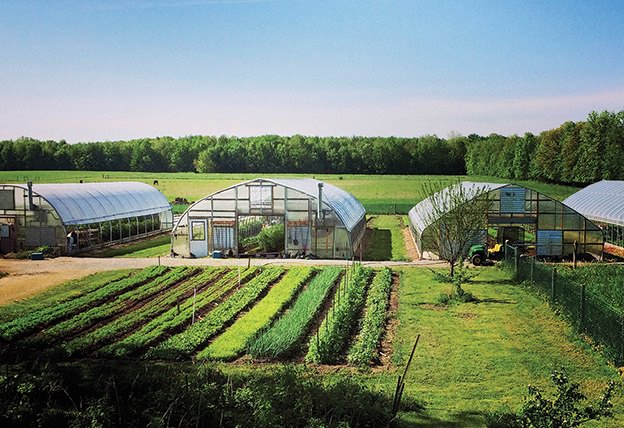
Farmers: Ben Hartman and Rachel Hershberger
Location: Goshen, Ind.
Specialty: Organic, in-season vegetables
Ben Hartman and Rachel Hershberger’s Clay Bottom Farm in northern Indiana is basically an archetypal hobby-farm success story. Starting in 2006 with just 1/4 acre of rented land and 10 CSA customers, the operation eventually broadened to farm ownership in 2008, which also allowed them to leave their existing nine-to-five jobs to farm full-time. Still farming on less than 1 acre of land, the couple uses an incredibly lean farm-management system, growing predominantly in four greenhouses, which keeps their production area small but efficiently managed.
Both Hartman and Hershberger have agriculture in their blood: He grew up on a corn and soybean farm, and her family kept a large garden and frequently preserved the bounty. Now, the pair focuses mainly on the desires of their CSA and market customers when deciding what to grow.
“We grow a lot of greens and tomatoes because those items are always popular with our customers,” Hartman says. “We were also excited about our fig harvest: Four years ago, we planted three fig trees in a greenhouse, and they produced well this year.”
In addition to growing for their customers, Hartman and Hershberger have also started to grow test crops for local universities.
“This year, we are working with Purdue University [in West Lafayette, Ind.] on a study of winter greens like Tokyo Bekana, Red Russian kale and tatsoi to determine which ones grow best in our area in unheated greenhouses,” Hartman says. “We’re excited to see which crops will be the winners.”
For more information on Clay Bottom Farm and how its unique farm-management system allows them to increase their profits with less work, check out Hartman’s book, The Lean Farm (Chelsea Green Publishing, 2015).
Biggest Success
We have a strong commitment to local food, and 90 percent of the food we grow ends up on plates within 10 miles of the farm.
Biggest Challenge
We sell a lot to restaurants, but the restaurant industry is volatile; there’s a lot of staff turnover, menus change and restaurants frequently close. We are constantly searching for ways to stay flexible and change what we do to keep up and stay relevant.
Firsthand Advice
There are many ways to grow a business. The typical model is to grow through constant expansion: Acquire more land, buy more tractors, produce more food, scrounge up more customers, etc. But you can also grow by staying small and cutting out your waste—in other words, by doing what you already do better. On our farm, we streamlined our tasks to remove wasted motion, we stopped growing crops with low margins, we got rid of half of our tools, and we took extra steps to give our customer precisely what they want when they want it. Because of these changes, we now earn a comfortable living on less than an acre of land while working reasonable hours.
This article originally ran in the January/February 2016 issue of Hobby Farms.




